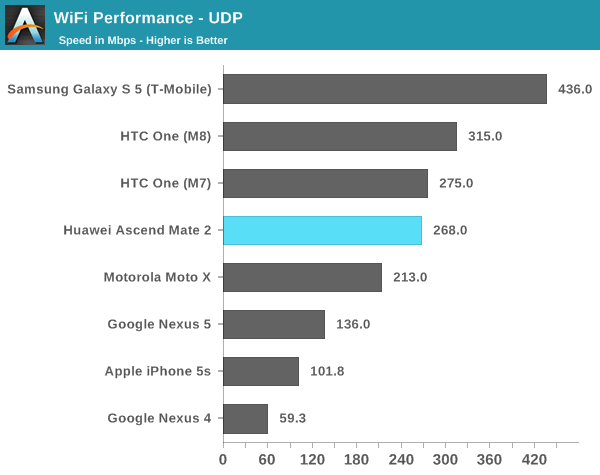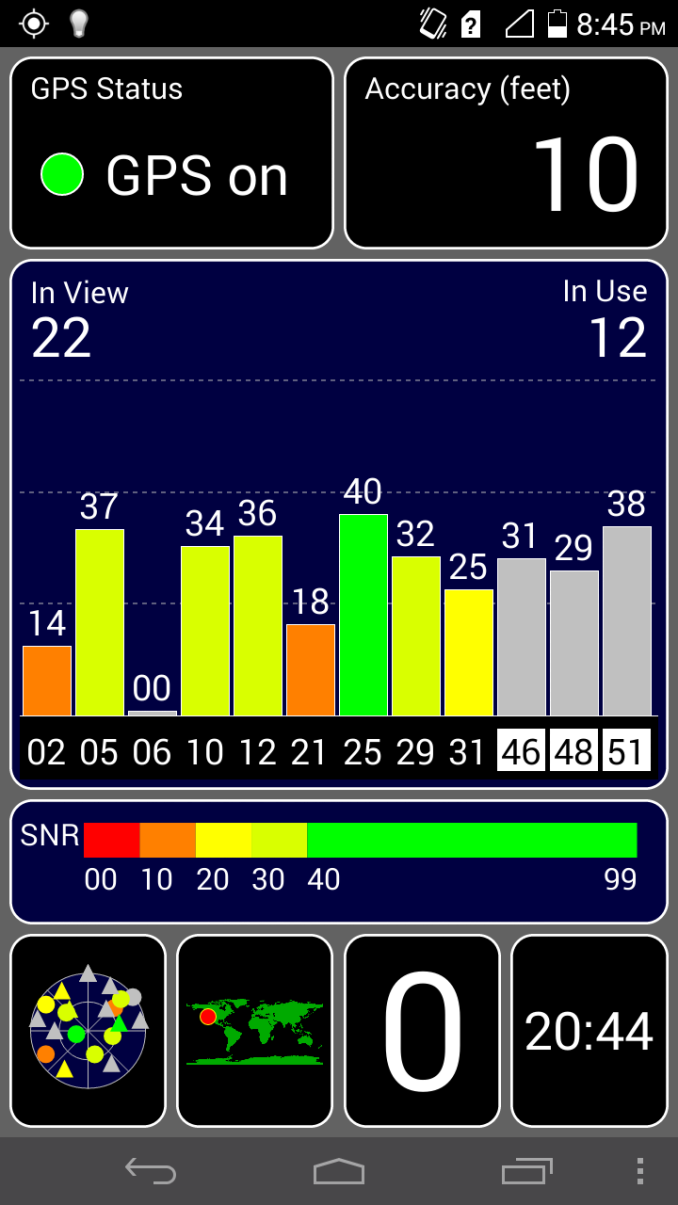Huawei Ascend Mate 2 Review: Incredible Battery Life & Value
by Anand Lal Shimpi & Joshua Ho on June 12, 2014 9:00 AM EST- Posted in
- Smartphones
- Huawei
- Mobile
- Ascend Mate 2
WiFi
It's self-evident that reaching lower price points will mean that compromises will have to happen. Ultimately, the big issue is where the compromises happen. While most people are willing to give up the niceties that the high-end, high-margin flagships have, far fewer are willing to compromise on fundamental parts of the experience. Unfortunately, WiFi is one of the areas that the average consumer and OEMs alike tend to see little issue with cheaping out on WiFi modules. That is, of course, until one deals with the pain of using a 2.4 GHz-only phone in an area where 5 GHz is the only usable spectrum.
Fortunately, Huawei hasn't done this at all. While the spec sheet doesn't give any immediate indication of the WiFi module in the Mate2, some digging through files such as the build.prop can give clues. The reference to a WCN WiFi part effectively limits the possible controllers to WCN3620, WCN3660, or WCN3680. From there, simply determining the band support and fastest 802.11 standard supported based on PHY rate and other information gives all the necessary information. In the case of the Ascend Mate2, we're looking at a WCN3680 part. This means that 2.4 and 5 GHz are both supported, with a maximum data rate of 433 Mbps via single spatial stream 802.11ac.

As seen by the graph above, the Ascend Mate2 does respectably well for maximum speed, although it's not quite as fast as the One (M8). Anything that doesn't support 802.11ac would be far slower than the Mate2.
GNSS
As with any MDM9x25 IP block, the Ascend Mate2 uses Qualcomm's GPSOne Gen8B, which supports GPS, GLONASS, and Beidou. I didn't notice any significant issues here, and I managed to acquire an accurate lock in around 10 seconds when doing a cold lock (no WiFi, no assistance data, airplane mode). A cursory search of the FCC documents for the Mate2 seems to lack any specific information on antenna placement for the phablet.
Cellular
Although I haven't had sufficient time to run a ton of speedtests to see the distribution of data speeds, the cellular architecture of the Ascend Mate2 is rather typical. There's receive diversity, but no transmit diversity, which means that this is similar to the Samsung Galaxy S4 in antenna setup. Based upon the FCC test data, this phone supports quad band GSM (850, 900, 1800, and 1900 MHz), and band I (2100 MHz), II (1900 MHz PCS), V (850MHz CLR), and IV (AWS 1700/2100 MHz) for quad band WCDMA. LTE band support is for bands 2, 4, 5, and 17 for AT&T and T-Mobile US LTE support. In short, there shouldn't be any issue getting this phone to work on US/Canada GSM operators.











49 Comments
View All Comments
Ketzal - Thursday, June 12, 2014 - link
Just a heads up, the results of your Nexus 5 web scores are WELL wrong. I ran the tests and received considerably better results than what's reported here in your tables. Obviously, Android and Chrome have moved on since the debut of the Nexus 5 last year. I believe you need to update your tables with some kind of statement to indicate test date as it's misleading and not a fair accurate comparison by date. I'm sure you tested the latest version of Chrome on the Huawei? Doesn't that immediately invalidate the table? I'm running stock 4.4.3 Android and ART. On another note, I'd love to see a performance graph update for each version of Android. I'm sure it would be very popular. Keep up the fantastic work.Impulses - Friday, June 13, 2014 - link
ART isn't enabled by default is it...groundhogdaze - Thursday, June 12, 2014 - link
Great battery life is a godsend for me. I've got so many gadgets that need charging that I'm almost to the point of needing to do triage on them.Electron? - Thursday, June 12, 2014 - link
This came as a surprise, but it's great to see a phone that really pushes the boundaries on battery life.Really hoping your next review will be the LG G3. Anandtech is pretty much the only site that goes in-depth on battery life these days.
JoshHo - Thursday, June 12, 2014 - link
I hope it is too. :)dawp - Thursday, June 12, 2014 - link
I have a prism2 from t-mobil which is a huawei device which I am generally been happy with, I'll have to look into this phablet when I bet a bit extraa cash.GNUminex_l_cowsay - Thursday, June 12, 2014 - link
I find it odd that you write a review of a device where in you you compare it e to phones that I would consider consider competing devices. But, then you don't include those phones you mentioned in the benchmark comparisons. I'm wondering why you didn't include say the onemaxx or note3?2 or 1mini or moto g. 3 of the phones l mentioned you mentioned and all seem like better comparison points to me than the phones used in the charts.KillaKilla - Thursday, June 12, 2014 - link
What happened with the photography? Anandtech has had good, or at the very least not bad, photography throughout for a decade or more, yet here it's mediocre at best, laughable at worst. One shot even has a reflection of the camera in it!rivethead23 - Thursday, June 12, 2014 - link
I currently own a Note 2. Bought it used for around $200. (Swappa!) I'm not bothered by the 5.5 screen (and size) on the Note 2 and actually looked at the Mega but ultimately decided against it. Since reviewer began by speaking about the note series I was disappointed to see no comparisons to the note series. Someone else mentioned the Note 2 would have been a good point of comparison and I think it would be.nrfitchett4 - Friday, March 20, 2015 - link
I bought my wife a note 3, brand new on swappa (not retail) and it was 450 dollars. This new on Amazon with 2 year warranty was 290. Its not really a fair comparison. Yes my wife's note 3 has a prettier screen, but that is about it. This is a solid midrange phablet and should be compared with other phones in the 200-400 new price point.